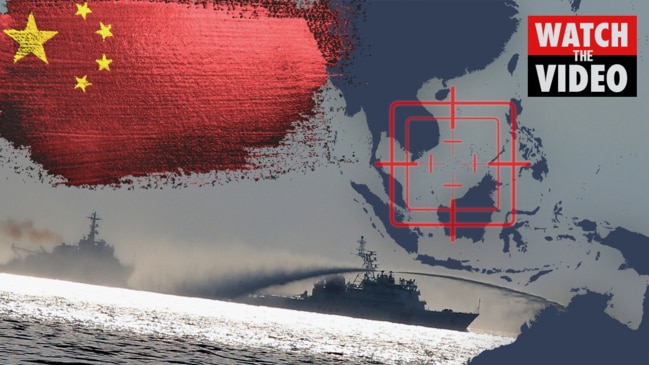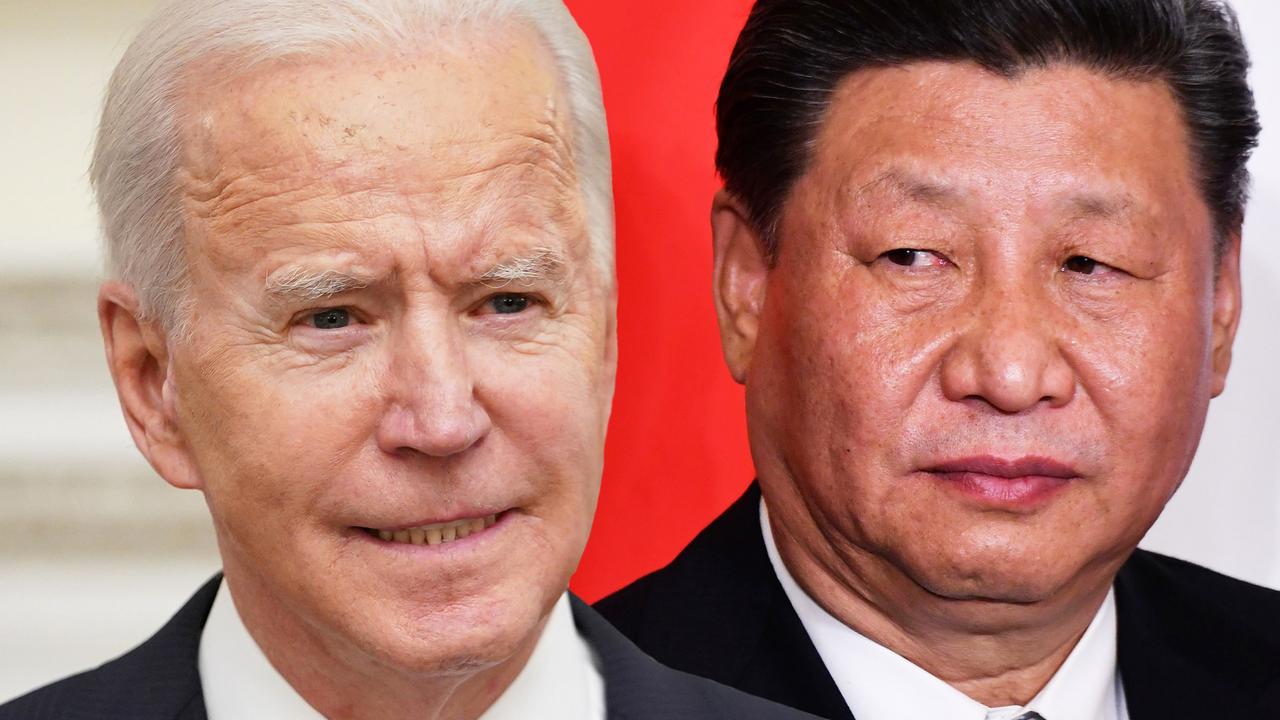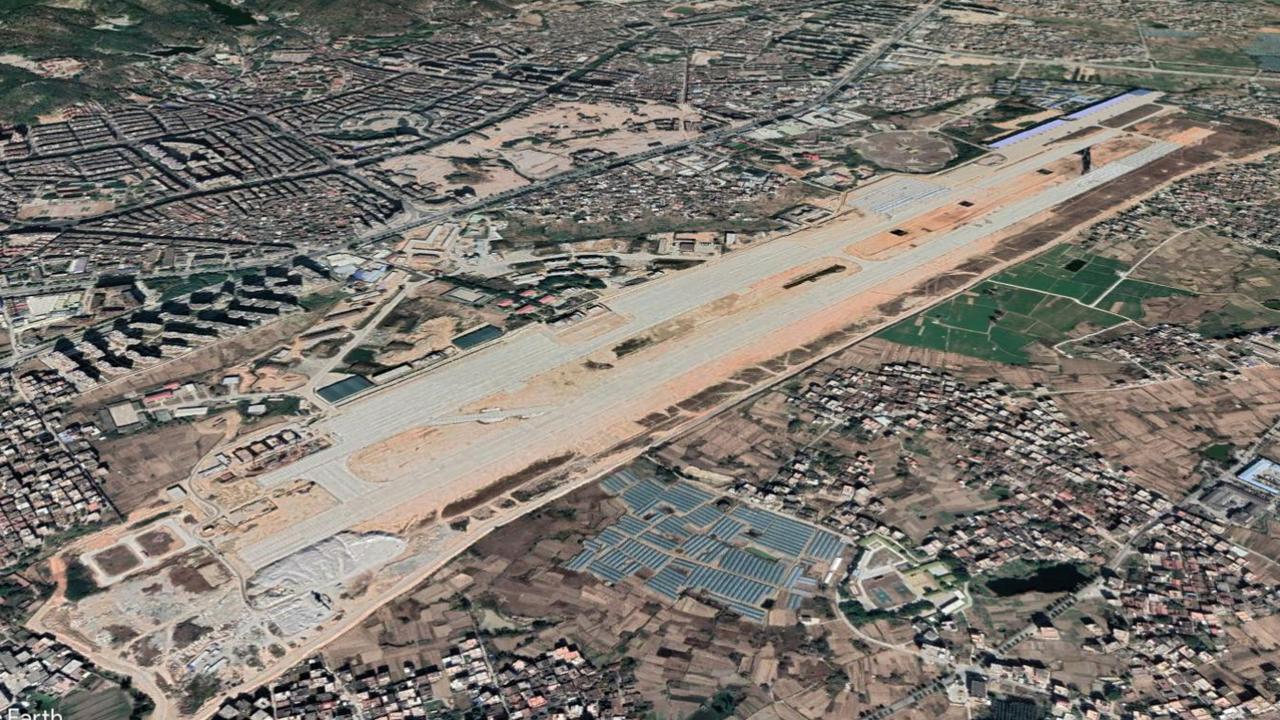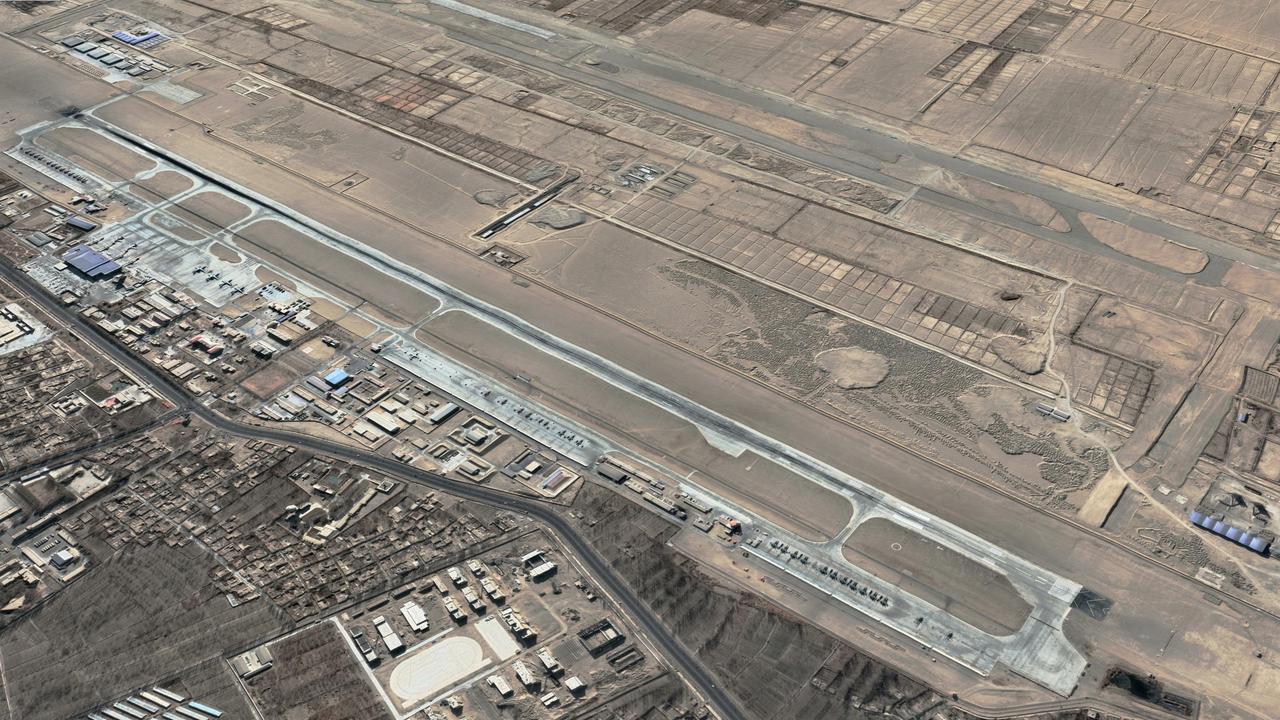Satellite images reveal massive expansion at Chinese airfield near Taiwan
China has declared it “must spend more” to meet the threat of war. Now images show exactly what their master plan involves.

A top Chinese general has declared his nation “must spend more” to meet the threat of war. But satellite photos reveal Beijing has already initiated a massive military airfield expansion campaign.
General Xu Qiliang is second only to Chairman Xi Jinping in the Chinese military chain of command. He’s also one of the core 25 members of the Communist Party’s Politburo.
As Chinese Communist Party (CCP) delegates met this weekend at the largely stage-managed National People’s Congress, General Xu declared China faced a “Thucydides Trap and border problems”.
The Thucydides Trap is an idea espoused by a Greek philosopher of the same name. In it, he declared waning powers would always end up in conflict with those on the rise. In essence, it’s a thinly veiled reference to growing tensions with the United States.
RELATED: Large-scale war: Grave warning for Taiwan

And Beijing’s growing ambitions over its borders with India, Japan, Taiwan, the Philippines, Malaysia, Vietnam and Indonesia have made clear in recent years.
“The military must speed up increasing its capacity,” General Xu declared. “(China) must make breakthroughs in combat methods and ability, and lay a sound foundation for military modernisation.”
There is increasing evidence such a dramatic modernisation and expansion program is already well underway.
Taiwan News has reported Google Earth images show massive expansion works at two People’s Liberation Army Air Force bases in the nearby Fujian Province. Open-source intelligence (OSINT) analysts are pouring over satellite imagery that shows similar dramatic construction work at facilities adjoining India, Vietnam, and the South China Sea.
RELATED: Danger lurking on Australia’s doorstep



TAIWAN UNDER SIEGE
Chinese Foreign Minister Wang Yi has once again declared that the US must not cross Beijing’s “red lines” such as Taiwan.
“The Chinese government has no room for compromise or concessions on the Taiwan issue,” Wang said. “We urge the new US administration to … “completely change the previous administration’s dangerous practices of ‘crossing the line’ and ‘playing with fire’.”
Meanwhile, Taiwan believes Beijing is making efforts to thicken their ‘red line’.
PLAAF air activity around the island democracy has escalated significantly in recent weeks and months. Bombers, long-range fighters and surveillance aircraft probe its borders on an almost daily basis.
China expands 2 air force bases closest to Taiwan https://t.co/zUDA6rA1tFpic.twitter.com/EO1eJYT6TW
— Taiwan News (@TaiwanNews886) March 8, 2021
Now two PLA bases immediately across the Taiwan Strait appear to be undergoing work to increase the number of aircraft they can send on such incursions. Runways are being extended and widened to operate more and heavier aircraft. Taxiways are being enlarged to serve as backup runways. Ammunition dumps are being expanded.
China’s Longtian and Huian Airbases are a mere seven-minute flying time from Taiwan’s capital Taipei (less than 200km distant).
Retired Taiwan Air Force commander Chang Yen-ting told Taiwan News that Beijing was strengthening its ability to “subdue the enemy without fighting” and wear-down Taiwan pilots and aircraft through the constant need to intercept incoming flights.
He said the sudden reconstruction of these air bases had prompted Taiwan’s military to undergo a detailed review of its defensive forces and positioning. He said such moves include dispersing radars and anti-aircraft missiles to reduce their vulnerability and enhance their coverage.
INDIA FRONT
Chinese and Indian troops have agreed to step back from their confrontation in remote Himalayan Ladakh. But both sides are actively upgrading military facilities close to the contested ‘Line of Control’.
The PLAAF Hotan Airbase is a crucial Chinese facility within reach of the conflict zone. Satellite photos reveal it also is undergoing a dramatic expansion.
Pivotal in supporting #China's airforce operations near #Ladakh the Hotan airbase has been undergoing infrastructural improvements aimed at boosting operational capability, summarized in this report are some of the changes seen in the last few months #TheIntelLabpic.twitter.com/5iUUlBIvN8
— d-atisâ˜ ï¸ (@detresfa_) February 1, 2021
OSINT analysts point to the construction of new hardened hangars, underground facilities, ammunition bunkers and workshops, and a 4200m long new runway with associated taxiways.
The older portion of the air base has also recently seen an upsurge in activity, with Beijing’s new J-20 stealth fighter and a range of new drones appearing alongside the J-11 interceptors and surveillance aircraft operated there.
A key airbase for the #IndianAirForce under its eastern command bordering with #China, the Chabua airbase has been undergoing renovations since 2017. Recent images help assess the improvements planned by #India to enhance future air operations from the site pic.twitter.com/kN57dE9bth
— d-atisâ˜ ï¸ (@detresfa_) March 8, 2021
Not far from #Doklam, the strategic #IndianAirForce base at #Hasimara has been undergoing large scale improvements since 2017, indicating #India's changing strategic goals to enhance its ability towards defending against any territorial encroachments in the sector pic.twitter.com/9Z1HTeDw7F
— d-atisâ˜ ï¸ (@detresfa_) February 2, 2021
India, for its part, has not been sitting idle. Its nearby Chabua and Hasimara air bases have been undergoing renovations since 2017. New hangars have been observed under construction, along with enlarged aircraft parking spaces and maintenance facilities.
The runways have also been receiving attention, with Hasimara getting an extension.
The Jammu military-civilian airport is also undergoing runway extension work that could enable it to operate a broader range of military aircraft.
SOUTH CHINA SEA
Beijing’s infamous South China Sea artificial island fortresses have not been the end of military construction work in the region, satellite photos reveal.
Mischief Reef, well inside the Philippines internationally recognised Exclusive Economic Zone (EEZ), has undergone radar and surveillance systems construction work. Satellite firm Simularity released images also indicating further construction in the harbour area.
US-based tech firm @simularity releases images showing China continues #SouthChinaSea construction in Mischief Reef since late 2020 until now, amid the pandemic. FULL details here: https://t.co/3rzqZSe3ybpic.twitter.com/gtX6x5m0CZ
— South China Sea Connect (@Scs_Connect) February 18, 2021
Recent activity was also reportedly detected on the Woody Island air base and port facility in the occupied Paracels.
But most of Beijing’s military facility expansion work in the region appears to have been focused on Hainan Island.
Quick and dirty, just showing the obvious. #China's Type-002 aircraft carrier and Type-075 assault carrier overlaid on the new dry dock under construction at Sanya, Hainan, South China Sea (#SCS). Didn't bother to rotate them. Imagery from Sentinel-2, ESA#Navy#AvGeekpic.twitter.com/QO5goEdbnn
— H I Sutton (@CovertShores) January 25, 2021
Two new dry docks are nearing completion, one of which appears large enough to accommodate China’s future Type 003 aircraft carrier. The facility is a clear indication Beijing intends to permanently base an aircraft carrier and its task force on the edge of the hotly disputed South China Sea.
Construction has also been observed on the nearby Sanya air base, suggesting it will operate carrier aircraft while they are not at sea aboard their ship.
China Improving Strategic Naval Base In The South China Sea - with new bunkers most likely permanent ammunition stores https://t.co/gmYeXbjGhL
— South China Sea News (@SCS_news) March 8, 2021
The island’s main Yulin Naval Air Base, meanwhile, has received new hardened bunkers, barracks and hangars.
Hainan island has become a central Chinese naval hub in recent years. Its nuclear submarines are housed in tunnels under a coastal mountain, while extensive underground storage and command facilities are believed to have also been built there.
RED LINES
General Xu told the National People’s Congress that China “made no promise to abandon the use of force”. Instead, Beijing “reserves the option of taking all necessary measures (to take control of Taiwan)”, he said.
The fault of current tensions was entirely Taiwan’s, the general insisted.
“The DPP authorities in Taiwan are relying on foreigners to seek “independence by force”, which runs against the overall national interests, severely harms the common interests of compatriots on both sides of the Taiwan Strait, and severely jeopardises cross-Strait peace and stability. It is extremely dangerous and has no way out,” Xu said.
China’s economy is now some 70 per cent that of the US, though many international experts believe it has already surpassed its Western competitor.
“This means we are already standing on the key position of a new chapter towards strength,” Xu said. “Our capabilities are always there and our will is firm as a rock.”
And Beijing shows every sign of consolidating that strength.
The weekend National People’s Congress rubber-stamped the Politburo’s request for a 6.8 per cent budget increase. However, the true extent of China’s military spending is hidden behind a complex web of secrecy and joint military-civil projects.
But Chairman Xi is relying on establishing a sense of crisis to continue the massive military build-up.
Shanghai-based naval expert Ni Lexiong told the South China Morning Post that the five-year plan pointed to Xi’s sensitivity to pressure from the United States, especially in the East and South China seas.
“Xi realises that there is a big gap between the PLA and the US military, and that the gap might widen further if Washington reinforces its scientific and technological bans on the defence industry,” Ni said.
“The most effective way is to use China’s top-down political system to mobilise all resources across sectors to accelerate military modernisation.”
Jamie Seidel is a freelance writer | @JamieSeidel




